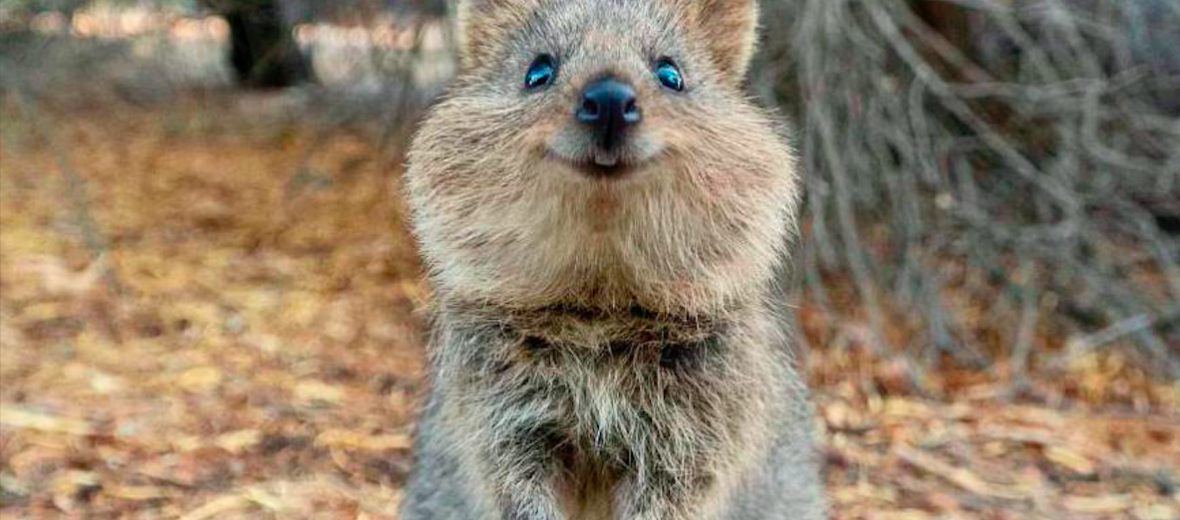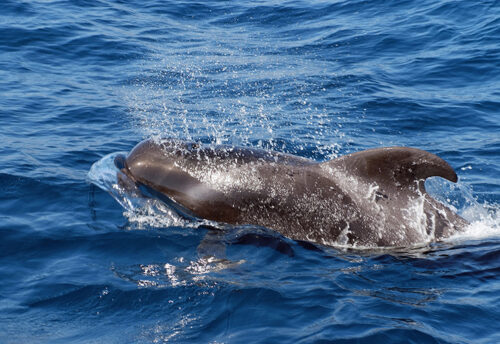
Native to Australia and about the size of a large house cat, it’s the quokka. Quokkas are marsupials, like kangaroos, wallabies, and wombats; to name a few. They hail from Rottnest and Bald islands. There is also a population in Two Peoples Bay Nature Reserve. When first discovered by European settlers, these cute critters were thought to be a species of cat. Later they were thought to be just very large rats. Known as the happiest critter in the world and being as popular as they are, these photogenic creatures are actually listed as Vulnerable by the IUCN. This is due in part to habitat destruction and the introduction of other animals.
First the Stats…
Scientific name: Setonix brachyurus
Weight: Up to 7 lbs.
Length: Up to 21 inches, plus a 12 inch tail
Lifespan: Up to 10 years
Now on to the Facts!
1.) First off, how the heck do you say their name? North Americans typically pronounce it “koo-WOH-kuh”, however, Australians pronounce it “kah-WAH-kah”.
2.) Rottnest island was actually named after a mistaken identification of quokkas. Since they were thought to be a species of rat, they named the island “Rotte nest.”
3.) Their common name was derived from the aboriginal “gwaga” or “kwaka”.
4.) They are able to avoid drinking standing water for almost an entire month by extracting their water from the plants they eat. Their favorite being guichenotia; a flowering bush.
5.) Quokkas are herbivores (eat plant matter) that like grasses and leaves.
But wait, there’s more on the quokka!
6.) Samuel Volckertzoon believed them to be a type of cat in 1658. In 1696, Willem de Vlamingh thought that they were rats.
7.) The quokka is considered to be a macropod, like other pouched mammals in Australia, New Guinea, and Tasmania.
Did you know…?
Mother’s instincts go right out the window when it comes to facing a predator. If presented with a foe, mom will eject her baby from her pouch, leaving it to squeal and squirm on the ground. This attracts the predator and gives mom a chance to escape.
8.) Since they have a tendency to just rip off vegetation and shove it in their mouths and swallow it whole. They don’t get any nutrition from their food the first time around. Thus they will regurgitate their dinner and eat it again. This way they make their own second helping.
9.) Being partially arboreal, they love to climb trees. They have been seen traveling up to 6 feet up a tree!
10.) They breed between January – March. Giving birth to a single joey.
But wait, there’s still more on the quokka!
11.) Quokkas literally have zero fear of humans as a result of living in a place that has a very low amount of predators; sans cats, dogs, and foxes. They will cozy right up to humans for a great selfie.
12.) Be warned though, it is forbidden to touch or feed them. You are welcome to take a selfie with these cute critters but touch 1 and you face jail time and up to a AUS$2,000 fine!
13.) These cuddly animals are also very intelligent and manipulative. They have learned that the cuter their behavior the more chance they have of getting a free handout of food. They have even learned to do tricks, act playful, and be downright jovial, just to get their way.
14.) Even though they always look like they’re smiling, they aren’t, it’s just how their jaws and cheeks have evolved.
15.) After all this, I’m sure you’re now in love with these adorable critters. But don’t get too attached, as they are a protected species, a wild animal, and Australia strictly prohibits import or export of animals. Plus, they may be cute, but they have been known to bite fingers when being fed and when they feel threatened. They’re wild and need to stay that way.
Now a Short Quokka Video!
Be sure to share & comment below! Also, check out the Critter Science YouTube channel. Videos added regularly!
Want to suggest a critter for me to write about? Let me know here.
Some source material acquired from: Wikipedia & IUCN




